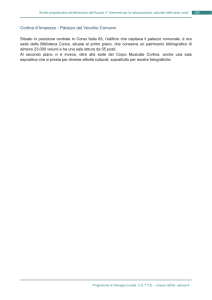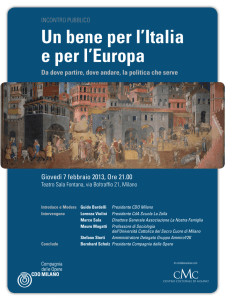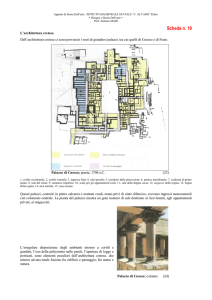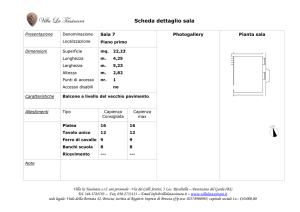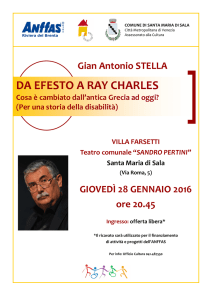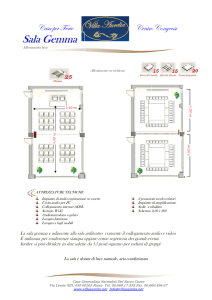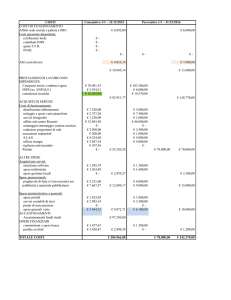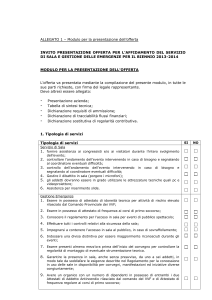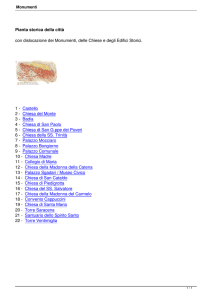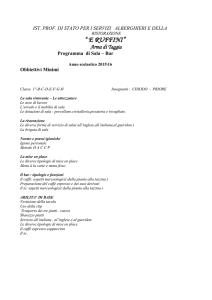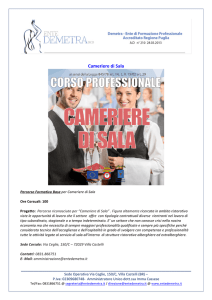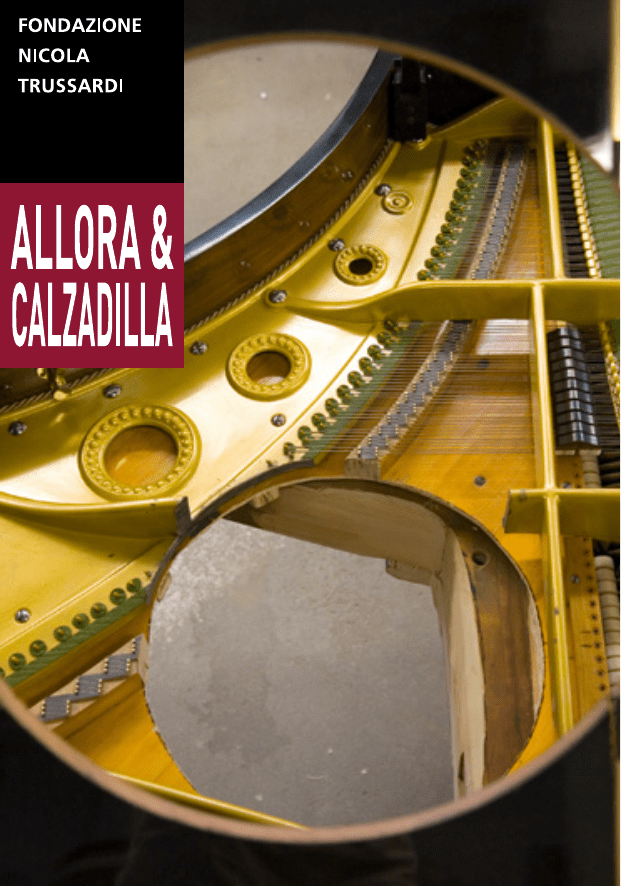
Fault Lines è la prima grande mostra personale in un’istituzione italiana di Allora & Calzadilla (Jennifer Allora, Filadelfia 1974; Guillermo Calzadilla, L’Avana 1971), coppia di artisti americani che lavora
insieme dal 1995 e che rappresenta una delle voci più impegnate del
panorama artistico internazionale. I loro video, le loro installazioni,
sculture e performance sono stati al centro di importanti mostre nei
musei e nelle kermesse più celebri del mondo, dal Museo d’Arte
Moderna di New York allo Stedeliijk Museum di Amsterdam alla
Biennale di Venezia, dove nel 2011 hanno rappresentato gli Stati
Uniti d’America.
Concepita per Palazzo Cusani – straordinario gioiello architettonico
nel cuore di Milano, da più di quattro secoli teatro di avvenimenti
politici e mondani che si sono intrecciati con la storia del nostro Paese – la mostra Fault Lines presenta un’imponente selezione di lavori
recenti e nuove produzioni, che riflettono sul concetto di confine
inteso come linea fisica e simbolica che separa due mondi, facendosi
limite, demarcazione, catalizzatore di tensione.
Come etnografi post-coloniali, Allora & Calzadilla scandagliano limiti e contraddizioni del mondo globale, combinando nei loro lavori
frammenti di una società in continua trasformazione di cui rileggono
gli eventi per tracciare mappe e percorsi dove tempo e spazio si fondono in potenti metafore. Con un gioco di continue sovrapposizioni
e sostituzioni, cambiamenti repentini e rotture, la coppia di artisti
compone un mosaico di geografie instabili ed equilibri precari, in cui
il corpo è terreno di confronto, di scontro, di scambio di energia, e
strumento con cui connettersi al resto del mondo. Le opere nascono dalla combinazione sperimentale di elementi e linguaggi diversi
– scultura, fotografia, performance, musica, suoni e video – utilizzati
come strumenti per esplorare le geografie psicologiche, politiche e
sociali della cultura contemporanea globalizzata. Per Allora & Calzadilla, infatti, l’arte è un pretesto per indagare concetti chiave del
nostro presente, quali l’identità nazionale, la democrazia, il potere,
la libertà, la partecipazione e i cambiamenti sociali. E proprio da
questo approccio nasce la scelta del titolo della mostra: Fault Lines
– letteralmente linee di faglia – sono quelle fratture del suolo che
si formano nel punto di incontro tra due masse rocciose in moviSediments, Sentiments (Figures of Speech), 2007
3
mento, linee frastagliate, instabili, che nascondono fragilità profonde, pronte ad arrivare da un momento all’altro al punto di rottura.
Nei magnifici spazi di Palazzo Cusani – per la prima volta aperti
all’arte contemporanea grazie alla collaborazione del Comando Militare Esercito Lombardia – si susseguono sculture sonore, performance, video e immagini che si intrecciano con la storia del luogo
e con la cronaca dei nostri giorni, destabilizzandole e riordinandole
secondo un ritmo narrativo che alterna sorpresa, poesia, umorismo
ed epifanie.
Sediments, Sentiments (Figures of Speech) (2007) è la prima
imponente scultura che si incontra nel cortile del Palazzo: un gigantesco bozzolo di poliuretano racchiude all’interno di cunicoli alcuni
cantanti lirici che interpretano brani tratti dai più importanti discorsi
ufficiali pronunciati dai protagonisti della storia del Novecento – da
Martin Luther King a Nikita Khrushchev, dal Dalai Lama a Saddam
Hussein – smontandone il linguaggio retorico e smascherandone
gli artifici. I frammenti dei discorsi sembrano emanare direttamente dalle forme geologiche della scultura come da uno strano sito
archeologico nel quale la storia torna in vita sotto forma di voce,
musica e respiro.
Sullo scalone d’onore che conduce all’interno del Palazzo, a fare
da contrappunto al settecentesco Affresco della Carità della scuola
del Tiepolo, un trombettista jazz improvvisa sulle note della sveglia
militare: reinterpretando in chiave sperimentale una composizione
tra le più conosciute, Wake Up (Rising) (2013) si ispira al ruolo e
all’importanza che la musica e i suoni rivestono nella vita militare.
La musica è protagonista anche di Stop, Repair, Prepare: Variations of ‘Ode to Joy’ for a Prepared Piano (2008), una delle
opere più conosciute di Allora & Calzadilla, che qui trova naturale
collocazione all’interno del maestoso Salone Radetzky, la sala da
ballo con stucchi e affreschi intitolata al generale austriaco che nel
Palazzo ebbe il suo quartier generale fino alle Cinque Giornate di
Milano (1848). Per l’opera gli artisti hanno modificato un pianoforte
Bechstein a coda di inizio Novecento, scavandovi un buco circolare:
ogni ora, un pianista in piedi al centro del piano, da dietro la tastiera
tenta di suonare il quarto movimento della Nona Sinfonia di Beetho-
4
5
Intermission (Halloween Afghanistan V), 2012
RETURNING A SOUND, 2004
6
ven. Comunemente conosciuto come Inno alla gioia, questo famoso
coro è da sempre evocato come rappresentazione musicale della
fraternità umana e della fratellanza universale, usato come inno nei
contesti ideologicamente più disparati, dalla Comunità europea alla
Rivoluzione Culturale cinese, dalla Supremazia Bianca in Rhodesia
al Terzo Reich, per citarne solo alcuni. Alle pareti del Salone due
tele della serie Intermission (Halloween Afganistan) (2012) che
raffigurano soldati dei contingenti americani di stanza in Afganistan
mentre festeggiano nel deserto la notte di Ognissanti, mascherati
da supereroi.
Il percorso prosegue all’interno della Sala Garibaldi con due opere
che dialogano con gli affreschi monocromi della volta, raffiguranti
gli eroi dell’antica Grecia accolti dal Pantheon romano. In un monitor viene trasmesso il video Returning a Sound (2004), sempre
incentrato sul tema della musica: un giovane attraversa il territorio
dell’isola di Vieques, a Porto Rico, su un ciclomotore che ha una
tromba saldata alla marmitta, producendo suoni che sono provocati
dai sobbalzi della strada e dall’accelerazione del motore. L’isola di
Vieques è stata per sessant’anni sede di una base militare americana
ed è stata restituita a Porto Rico solo nel 2001: il video suggerisce
una forma di riappropriazione del paesaggio naturale e sonoro, che
per i residenti dell’isola rimane segnato dal ricordo della violenza
acustica dei bombardamenti e delle esercitazioni. Nella stessa sala,
su una mensola, poggia la fotografia Land Mark (Footprints)
(2004) che fa parte dello stesso ciclo di lavori creati a Porto Rico,
luogo di residenza degli artisti: le impronte di scarpe lasciate da un
gruppo di attivisti sulla sabbia bianca della spiaggia di Vieques si
sovrappongono e si confondono lanciando dei messaggi leggibili
solo a chi passerà subito dopo.
All’interno della successiva Sala della Braida, dodici ballerini danno
vita alla performance Revolving Door (2011): un gruppo di persone accoglie gli spettatori schierato in fila, tagliando a metà lo spazio
da una parete all’altra, come una barricata umana. I performer si
muovono ritmicamente: marciano, camminano, si fermano seguendo una coreografia circolare che li trasforma in una porta girevole
umana. La sequenza dei passi raccoglie e mixa movimenti ispirati a
marce militari, cortei e coreografie di ballo, proponendo una riflessione poetica sull’utilizzo dei gesti e la loro funzione nella costru-
LAND MARK (FOOTPRINTS), 2004
zione di una comunità. I visitatori possono attraversare la stanza
solo seguendo il movimento della porta girevole, assecondandone
il ritmo, mettendo così in atto una complessa dinamica di relazione
tra il gruppo e l’individuo.
Si prosegue nella Sala delle Allegorie – prezioso scrigno dalla volta
affrescata con aquile angolari ad ali spiegate che punteggiano altrettante scene allegoriche tratte dalla mitologia greca – che accoglie la
proiezione di Raptor’s Rapture (2012), film presentato lo scorso
anno a Documenta a Kassel, ed esposto in quest’occasione per la
prima volta in Italia. Bernadette Käfer, musicista specializzata nello
studio di strumenti preistorici, suona un flauto di 35.000 anni fa, realizzato con ossa delle ali di un grifone, un maestoso uccello che nel
video osserva e ascolta gli sforzi della musicista. Il flauto, scoperto di
recente in Germania, è il più antico strumento musicale conosciuto
al mondo, simbolo degli albori della cultura umana, mentre il grifone, rapace europeo dall’incredibile apertura alare e dal nome di una
creatura mitologica, è un animale in via di estinzione. Il film mette in
scena un tentativo di dialogo e di condivisione tra uomo e animale,
accomunando l’evoluzione della cultura umana a quella della specie
animale e soffermandosi sulla nascita della musica come momento
7
fondante di una nuova fase della storia dell’umanità. Nell’angolo
opposto della sala, la scultura in bronzo The Bird of Hermes is My
Name, Eating My Wings to Make Me Tame (2010) – un elmetto
militare per azioni speciali, con videocamera e microfono, da cui
spuntano ali di uccello – è una rappresentazione contemporanea di
Ermes, divinità della mitologia greca, messaggero degli dei, protettore dei viaggiatori, dio delle transizioni e dei confini. Inventore del
flauto, Ermes era l’unica creatura che aveva il potere di entrare come
messaggero divino nell’Ade e di uscirne senza alcuna conseguenza,
capace di attraversare incolume i territori del mondo, della storia e
della morte.
La Sala dell’Ingegno fa da cornice alla scultura Cyclonic Palm Tree
(2004): ruotando in senso antiorario – lo stesso senso di rotazione
dei cicloni che si formano al largo della costa africana per poi svilupparsi di fronte ai Caraibi e, infine, abbattersi sugli Stati Uniti – una
ventola attraversa il tronco di una palma alta cinque metri creando
un piccolo uragano domestico. Su un monitor accanto alla scultura
viene trasmesso il video Sweat Glands, Sweat Lands (2006), girato
8
THE BIRD OF HERMES IS MY NAME, EATING MY WINGS TO MAKE ME TAME, 2010
a Loiza, a Porto Rico: un maiale viene arrostito su uno speciale spiedo infilato nella ruota posteriore di un’automobile. Quando l’auto
accelera anche lo spiedo gira più velocemente, mentre in sottofondo la voce di Residente Calle 13, un giovane cantante locale, si rivolge allo spettatore in spagnolo scandendo un rap free-style scritto in
collaborazione con gli artisti. Il brano evoca esempi di organizzazioni
sociali alternative a quelle dell’uomo: tra finzione e realtà, il mondo descritto dal brano rap è uno stato antagonista dove convivono
ordine e disordine, civiltà e barbarie in un’epoca di globalizzazione
armata.
La successiva Sala degli Intarsi ospita il video Apotomē (2013), secondo capitolo di una trilogia esposta in anteprima assoluta in Italia
– di cui Raptor’s Rapture è il primo episodio – incentrata sui rapporti
ancestrali che legano uomo, animale e natura attraverso la musica.
Realizzato all’interno del Muséum national d’Histoire naturelle di
Parigi, il video prende come spunto la storia di Hans e Parkie, due
elefanti portati a Parigi come trofei di guerra nel 1798. Nello stesso
anno la Società delle Scienze aveva organizzato un concerto per i
due pachidermi al Jardin des Plantes, al fine di testare gli effetti della
musica sugli animali in cattività e di stabilire una forma di comunicazione tra esseri umani e mondo animale. Rinnovando gli intenti del
primo esperimento, gli artisti hanno fatto eseguire di fronte ai resti
dei due elefanti una selezione di brani di quello stesso concerto al
cantante Tim Storms, l’uomo che grazie a una particolare estensione delle corde vocali riesce a toccare le note più basse del mondo
– 0.189Hz, ben otto ottave sotto il Sol più basso del pianoforte – la
cui frequenza può essere udita solo dagli elefanti. Nel video vediamo Storms passeggiare tra i corridoi del Muséum national d’Histoire
naturelle e intonare una surreale e malinconica serenata mentre accarezza le ossa degli elefanti Hans e Parkie.
Sotto lo straordinario soffitto affrescato dell’ultima sala, quella degli
Amorini, spunta Petrified Petrol Pump (2012), una pompa di benzina abbandonata che il tempo ha trasformato in un fossile dell’era
contemporanea. Reperto archeologico del futuro, questo manufatto umano - simbolo della folle corsa allo sfruttamento delle risorse
naturali – sembra essere stato inghiottito e poi espulso dalla natura, come un corpo estraneo, un rifiuto inquinante e distruttivo che
esprime la precarietà del rapporto uomo-ambiente su cui è costruita
9
10
la nostra civiltà.
Infine, chiude il percorso il video 3 (2013), terzo capitolo della trilogia
dedicata al rapporto uomo, animale, natura e musica, di cui fanno
parte Raptor’s Rapture e Apotomē. Il video ruota attorno alla celebre
Venere di Lespugue, manufatto in avorio di mammut risalente a circa 25.000 anni fa che raffigura una Venere steatopigia, una figura
antropomorfa dalle accentuate caratteristiche femminili. La preziosa
statuetta paleolitica – conservata al Musée de l’Homme di Parigi e
filmata per la prima volta in quest’occasione – costituisce una delle
più antiche raffigurazioni del corpo umano mai rinvenute. Ci sono
molte ipotesi che circondano il peculiare ideale di bellezza di questa
Venere, le cui proporzioni esagerate sfiorano la deformità: per alcuni studiosi è simbolo di fertilità, per altri rappresenta una divinità
religiosa preistorica, mentre per il matematico Ralph H. Abraham e
per il filosofo William Irwin Thompson le misure lineari del suo corpo
corrispondono perfettamente alla scala musicale diatonica, conosciuta come il modo dorico degli antichi greci. Il video tenta quindi di
rappresentare, in termini visivi e musicali, un processo di trascrizione
della figura della Venere in musica, usando le proporzioni della sta-
tuetta come una scala musicale. Sulla base di questo canone il compositore David Lang ha scritto una partitura per violoncello, eseguita
dalla violoncellista Maya Beiser di fronte al prezioso reperto, che si
trasforma così in uno spartito tridimensionale.
Con la mostra Fault Lines Allora & Calzadilla trasformano le sontuose sale barocche del palazzo in un variopinto carillon, dando vita
a un percorso in cui suoni e musica diventano metafore di rapporti di forza, conquista, resistenza e seduzione, mettendo al centro
i modi in cui la musica e i suoni possono trasformarsi in portatori
di leggende, miti e valori, diventando al tempo stesso strumento
per conoscere noi stessi, la nostra storia, e tracciare le basi per un
cambiamento futuro.
RAPTOR’S RAPTURE, 2012
RAPTOR’S RAPTURE, 2012
11
12
Fault Lines is the first major solo exhibition in Italy by Allora & Calzadilla (Jennifer Allora, b. 1974 in Philadelphia; Guillermo Calzadilla,
b. 1971 in Havana); an American artistic duo that has been working
together since 1995, they are among the most active and socially engaged voices on the international art scene. Their videos, installations,
sculptures and performances have been featured in major exhibitions
at the world’s most famous museums and festivals, ranging from
MoMA in New York, to the Stedeliijk Museum in Amsterdam, to the
Venice Biennale, where they represented the United States in 2011.
Conceived for Palazzo Cusani—an extraordinary gem of architecture in the heart of Milan, which for over four centuries has been the
scene of historical, cultural, political, and social events that are deeply
interwoven with the story of Italy—Fault Lines presents an impressive
selection of new and recent pieces that examine the concept of borders as physical and symbolic dividing lines.
Allora & Calzadilla plumb the limits and contradictions of the global
world, tracing maps and routes where time and space merge together
to form powerful metaphors. By means of creative combinations,
substitutions, inversions, and breaks, the duo composes a mosaic of
fickle landscapes and precarious equilibriums that foreground the
body as the primary site of both communion and contention, connecting people to each other and to the world at large. These works have grown out of experimentation with different elements and
languages—such as sculpture, photography, performance, music,
sound, and video—which are combined to explore the psychological,
political, and social geography of contemporary globalized culture.
For Allora & Calzadilla, art is a way to investigate pivotal concepts of
our time such as nationalism, democracy, power, freedom, participation, and social change. This approach is what inspired the title for
their exhibition: Fault Lines, the rifts in the earth that form between
two shifting masses of rock; ragged, unstable fissures that conceal a
deep fragility, and could reach the breaking point at any moment. In
the magnificent spaces of Palazzo Cusani—open for the first time to
the world of contemporary art through the collaboration of the Army
Command for Lombardy—viewers encounter a succession of sounds,
sculptures, performances, videos, and images that intertwine with the
SEDIMENTS, SENTIMENTS (FIGURES OF SPEECH), 2007
13
14
history of the site and the story of our times, disrupting them only
to piece them back together with a narrative rhythm that alternates
surprise, poetry, humor and epiphany.
Sediments, Sentiments (Figures of Speech) (2007) is the first imposing sculpture that greets visitors in the courtyard of the palazzo.
Inside this gigantic foam and plaster form, opera singers perform passages from the most significant speeches of the twentieth century—
from Martin Luther King to Nikita Khrushchev, and from the Dalai
Lama to Saddam Hussein—dismantling their language and revealing
their rhetorical devices. The speech fragments seem to issue directly
from the geological sediment of the sculpture, like a strange archeological site where history comes back to life in the form of voice,
music, and breath.
On the grand staircase leading into the palazzo, as a counterpoint to
the eighteenth-century Affresco della Carità by a follower of Tiepolo, a jazz trumpetist improvises on the notes of the military Reveille.
Reworking one of the world’s most familiar melodies, Wake Up (Rising) (2013) draws inspiration from the pivotal role that sound and
music play in military life.
Music is also at the heart of Stop, Repair, Prepare: Variations of
‘Ode to Joy’ for a Prepared Piano (2008), one of Allora & Calzadilla’s best-known works, which finds a natural habitat here in the
majestic Salone Radetzky—a ballroom with its original stucco and
frescoes, named after the Austrian general who had his headquarters
in the palazzo until the Milan uprising. For this work, the artists have
modified a Bechstein grand piano from the early twentieth century
by carving a circular hole in it; once an hour, a pianist standing in the
void behind the keyboard attempts to play the fourth movement of
Beethoven’s Ninth Symphony. Commonly known as the Ode to Joy,
this famous final chorus has long been invoked as a musical representation of human fraternity and universal brotherhood in contexts as
ideologically disparate as the European Union, the Chinese Cultural
Revolution, white-supremacist Rhodesia, and the Third Reich, among
many others. Hung on the ballroom walls are two paintings from
the series Intermission (Halloween Afghanistan) (2012), showing
American troops stationed in Afghanistan as they celebrate HalloweWake Up (Rising), 2013
16
17
Stop, Repair, Prepare: Variations on ‘Ode to Joy’ for a Prepared Piano, 2008
18
en in the desert, dressed up as superheroes.
The exhibition continues in the Sala Garibaldi, where two works weave a dialogue with the monochrome frescoes of the vaulted ceiling,
which depict the heroes of ancient Greece being welcomed into the
Roman pantheon. Shown on a monitor is the video Returning a
Sound (2004), once again centered on the theme of music: a young
man rides across the island of Vieques, in Puerto Rico, on a moped
that has a trumpet welded to the muffler, generating sounds with
each jolt in the road or acceleration of the engine. For 60 years, the
island of Vieques housed a US military base, and was returned to
Puerto Rico only in 2001; the video suggests a reclamation of its landscape and soundscape, which for residents continues to be scarred by
the memory of military bombing exercises and their acoustic violence.
Standing on a shelf in the same room is the photograph Land Mark
(Footprints) (2004) which belongs to the same cycle of works created in Puerto Rico, where the artists live: images imprinted on the
white sand of the Vieques beach by the shoes of activists overlap and
blur together, leaving messages that can be discerned only by those
who happen upon them just after the fact.
In the adjacent Sala della Braida, twelve dancers enact Revolving
Door (2011): visitors are greeted by a line of people stretching across
the space from wall to wall, like a barricade. The performers mar-
ch and stop in a circular motion that transforms them into a human
revolving door. The choreographed sequence of movements, drawn
from political protests, military marches, and chorus lines, offers a
poetic meditation on the use of gestures and its role in forging communities. Visitors can walk through the room only by following the
revolving door and joining in its rhythm, highlighting the complex
dynamics of interaction between group and individual.
Moving on, the Sala delle Allegorie—a jewel of a room whose frescoed ceilings feature eagles with outspread wings and scenes from Greek mythology—houses the screening of Raptor’s Rapture (2012),
a film presented last year at Documenta in Kassel and shown here
for the first time in Italy. Bernadette Käfer, a flautist specialized in
prehistoric instruments, plays a 35,000-year-old flute carved from the
wing bone of a griffon vulture, a majestic bird shown in the video as it
watches and listens to the musician’s efforts. This flute, recently unearthed in Germany, is the world’s oldest known musical instrument, a
symbol of the dawn of human culture, whereas the griffon vulture, a
European raptor with an amazing wingspan and a name straight out
of mythology, is an bird now threatened by extinction. The film portrays an attempt at dialogue and a moment of communion between
woman and animal, tying together human and animal evolution and
reflecting on the birth of music as a milestone event in human history.
APOTOMĒ, 2013
APOTOMĒ, 2013
19
20
In the opposite corner of the room, the bronze sculpture The Bird
of Hermes is My Name, Eating My Wings to Make Me Tame
(2010)—cast from a special-ops helmet with battlefield accessories
like camera and microphone, but also fitted here with wings—is a
contemporary representation of Hermes, the Greek deity who was a
divine messenger, protector of travellers, and the god of transitions
and borders. The inventor of the flute, Hermes was the only being
capable of entering and leaving Hades at will, travelling unharmed
across every realm of the world, of history, and of death.
The Sala dell’Ingegno instead houses Cyclonic Palm Tree (2004): rotating counter-clockwise—the same direction as the cyclones which
form off the coast of Africa, develop in the Caribbean or Atlantic,
and finally arrive in the United States—a fan cuts through the trunk
of a five-meter-tall palm tree, creating a little domestic hurricane. A
monitor next to the sculpture shows the video Sweat Glands, Sweat Lands (2006), shot in Loiza, Puerto Rico, in which a pig is being
roasted on a special spit attached to the back wheel of a car. When
the engine is revved, the spit turns faster, while the voice of Residente
Calle 13, a young reggaeton singer from Puerto Rico, addresses the
viewer in Spanish in a free-form rap written in collaboration with the
artists. The piece evokes examples of non-human social organizations
as possible alternative modes of being-in-common: part reality, part
fiction, the world the singer describes is an antagonistic state of order
and disorder, civility and barbarity, in an age of armed globalization.
The adjacent Sala degli Intarsi houses the video Apotome¯ (2013),
the second chapter (after Raptor’s Rapture) of a trilogy shown here
in its Italian premiere, which centers on the ancestral ties that link together humankind, the animal world and nature through music. Shot
inside the Muséum national d’Histoire naturelle in Paris, the video is
inspired by the story of Hans and Parkie, two elephants brought to
the French capital as spoils of war in 1798. That year, a concert was
organized for the two pachyderms in the Jardin des Plantes, to test
the effects of music on animals in captivity and establish a channel of
communication between the human and animal world. Evoking the
spirit of this experiment, the artists arranged another performance to
be held before the bones of the two elephants: a selection of pieces
from the previous concert, sung by vocalist Tim Storms. Storms has
the world’s lowest voice: a unique range can that can reach notes
down to 0.189Hz, a full eight octaves below the lowest G on the
piano, and so low that only animals the size of elephants can hear
them. In the video, we see him walking through the halls of the natural history museum, performing a surreal, melancholy serenade as he
caresses the bones of the Hans and Parkie.
The extraordinary frescoed ceiling in the last room, the Sala degli
3, 2013
3, 2013
21
22
Amorini, frames the sculpture Petrified Petrol Pump (2012), an
abandoned fuel dispenser that time has turned into a fossil of our era.
An archeological artefact from the future, this man-made object—
symbolizing the mad rush to exploit natural resources that underlies
contemporary technology—seems to have been swallowed up and
spit out again by nature, like an piece of alien refuse, a destructive
source of pollution that embodies the precarious relationship between man and nature on which our civilization is built.
The exhibition comes to an end with the video 3 (2013), the third
chapter in the trilogy exploring the ties between man, animal, nature and music, to which Raptor’s Rapture and Apotome¯ also belong.
The video revolves around the famous Venus of Lespugue, an object
carved out of a mammoth tusk some 25,000 years ago, showing a
steatopygous Venus, an anthropomorphic figurine with accentuated
female secondary sex characteristics. This precious Paleolithic statuette—which resides at the Musée de l’Homme in Paris and was filmed
for the first time on this occasion—is one of the oldest depictions of
the human body ever discovered. There are many hypotheses surrounding the peculiar ideal of beauty found in this Venus, whose
exaggerated proportions could be read almost as deformities: some
scholars see her as a fertility symbol, others as a prehistoric deity, whereas mathematician Ralph H. Abraham and philosopher William Irwin
Thompson argue that her body’s linear measurements closely match
the diatonic musical scale, known as the Dorian mode of the Ancient
Greeks. The video thus attempts to portray, in visual and musical terms, a process of transcribing the Venus figure into music, using the
proportions of the statue as a musical scale. Based upon these rules,
composer David Lang has written a piece for solo cello, performed
by cellist Maya Beiser in the presence of this precious artefact, which
thus becomes a three-dimensional score.
With the exhibition Fault Lines, Allora & Calzadilla transform the
sumptuous Baroque rooms of the Palazzo into a many-hued music
box in which sound acts as a metaphor for relationships of power, resistance, and seduction, and as a tool of self-knowledge, to examine
our history and lay the foundations of future change.
Revolving Door, 2011
23
24
ALLORA & CALZADILLA
ALLORA & CALZADILLA
Jennifer Allora è nata a Filadelfia, negli Stati Uniti, nel 1974.
Guillermo Calzadilla è nato a L’Avana, a Cuba, nel 1971.
Si sono incontrati durante un viaggio di studio a Firenze nel 1995 e da quel
momento hanno iniziato a collaborare.
Vivono e lavorano a San Juan, Porto Rico.
Jennifer Allora was born in Philadelphia, USA, in 1974.
Guillermo Calzadilla was born in Havana, Cuba, in 1971.
They met on a study program in Florence and began collaborating in 1995.
They live and work in San Juan, Puerto Rico.
Parallelamente agli studi all’Università di Richmond, un Master in Scienze al
Massachusetts Institute of Technology e una borsa di studio all’Art Independent Study Program del Whitney Museum per Jennifer Allora, e agli studi alla
Escuela de Artes Plásticas a San Juan e un Master al Bard College per Guillermo Calzadilla, la coppia ha intrapreso una carriera artistica che li ha portati a
esporre nei più importanti musei del mondo.
Nel 2004 hanno vinto il Gwangju Biennale Prize indetto dall’omonima Biennale in Corea, mentre nel 2006 sono stati finalisti dell’Hugo Boss Prize del
Guggenheim Museum di New York e del Nam June Paik Award di Dusseldorf.
Nel 2010 sono stati finalisti per il 4th Plinth Commission, per la realizzazione
di una scultura temporanea a Trafalgar Square, a Londra.
I loro video, le loro installazioni, sculture e performance sono stati esposti in
mostre personali nelle principali istituzioni internazionali, tra cui l’Indianapolis
Museum of Art (2012), il Castello di Rivoli (2011), il Museum of Modern Art di
New York (2010), il National Museum of Art, Architecture, and Design di Oslo
(2009), il Kunstmuseum Krefeld (2009), l’Haus der Kunst di Munich (2008),
la Kunstverein Munich (2008), lo Stedeliijk Museum di Amsterdam (2008), la
Kunsthalle di Zurigo (2007), la Serpentine Gallery di Londra (2007), la Renaissance Society di Chicago (2007), la Whitechapel Gallery di Londra (2007), il
Palais de Tokyo di Parigi (2006), lo S.M.A.K - Stedelijk Museum voor Actuele
Kunst di Ghent (2006), il Dallas Museum of Art (2006). Hanno preso parte
alle maggiori kermesse internazionali, tra cui Documenta a Kassel (2011), la
Biennale di Venezia (2011, 2005), la Biennale di San Paolo a San Paolo del
Brasile (2011, 1998), Performa a New York (2009), la Biennale di Gwangju in
Corea (2008, 2006), la Biennale di Lione (2007, 2005), la Biennale di Istanbul
(2007), la Biennale di Sharjah (2007), la Biennale di Mosca (2007, 2005) e la
Biennale del Whitney Museum di New York (2006).
Nel 2011 hanno rappresentato gli Stati Uniti d’America alla 54. Esposizione
Internazionale d’Arte della Biennale di Venezia.
Parallel to their studies—Jennifer Allora’s at the University of Richmond, with
an MS from the Massachusetts Institute of Technology and a fellowship at the
Whitney Museum of American Art Independent Study Program; Guillermo
Calzadilla’s at the Escuela de Artes Plasticas in San Juan, with an MFA from
Bard College—the couple embarked on an artistic career that has led them to
exhibit in the world’s most important museums.
In 2004 they won the Gwangju Biennale Prize in Korea, while in 2006 they
were finalists for the Guggenheim’s Hugo Boss Prize in New York and the
Nam June Paik Award in Dusseldorf. In 2010 they were shortlisted by the
Fourth Plinth Commission to create a temporary sculpture for London’s Trafalgar Square.
Their videos, installations, sculptures and performances have been featured
in solo exhibitions at the world’s most prominent institutions, including the
Indianapolis Museum of Art (2012), Castello di Rivoli in Turin (2011), the Museum of Modern Art in New York (2010), The National Museum of Art, Architecture, and Design, Oslo (2009), the Kunstmuseum Krefeld (2009), Haus
der Kunst in Munich (2008), the Kunstverein Munich (2008), the Stedeliijk
Museum in Amsterdam (2008), the Kunsthalle in Zurich (2007), the Serpentine Gallery in London (2007), the Renaissance Society in Chicago (2007),
Whitechapel Gallery in London (2007), the Palais de Tokyo in Paris (2006),
S.M.A.K - Stedelijk Museum voor Actuele Kunst in Ghent (2006), and the
Dallas Museum of Art (2006). They have taken part in leading international festivals such as Documenta in Kassel (2011), the Venice Biennale (2011,
2005), the São Paulo Biennial (2011, 1998), Performa in New York (2009),
the Gwangju Biennale (2008, 2006), the Biennale de Lyon (2007, 2005), the
Istanbul Biennial (2007), the Sharjah Biennial (2007), the Moscow Biennale
(2007, 2005) and the Whitney Biennial in New York (2006).
In 2011 they represented the United States of America at the 54th International Art Exhibition of the Venice Biennale.
Fault Lines con la Fondazione Nicola Trussardi è la loro prima grande mostra
personale in un’istituzione italiana, e la più grande mostra personale che abbiano mai realizzato.
Fault Lines with the Fondazione Nicola Trussardi is their first major solo exhibition in Italy, and their biggest solo show to date.
25
14
SALA DEGLI
AMORINI
SALA
ROSSA
13
SALA DEGLI
INTARSI
SALA
DELL’INGEGNO
12
SALA DELLE
ALLEGORIE
9
10
11
CORTILE / COURTYARD
1. Sediments, Sentiments (Figures of Speech), 2007
SALA DELLA
BRAIDA
6
7
5
SALA
GARIBALDI
8
4b
SCALONE D’ONORE
2. Wake Up (Rising), 2013
SALONE RADETZKY
3. Stop, Repair, Prepare: Variations on ‘Ode to Joy’ for
a Prepared Piano, 2008
4a. Intermission (Halloween Afghanistan IV), 2012
4b. Intermission (Halloween Afghanistan V), 2012
3
SALA RADETZKY
SALA GARIBALDI
5. Returning a Sound, 2004
6. Land Mark (Footprints), 2004
SALA DELLA BRAIDA
7. Revolving Door, 2011
SALA DELLE ALLEGORIE
8. Raptor’s Rapture, 2012
9. The Bird of Hermes is My Name, Eating My Wings
to Make Me Tame, 2010
1
CORTILE / COURTYARD
4a
2
SALA DELL’INGEGNO
10. Ciclonic Palm Tree, 2004
11. Sweat Glands, Sweat Lands, 2006
SALA DEGLI INTARSI
12. Apotomē, 2013
SCALONE
D’ONORE
SALA DEGLI AMORINI
13. Petrified Petrol Pump, 2012
SALA ROSSA
14. 3, 2013
ENTRATA / ENTRANCE
CORTILE
1. Sediments, Sentiments (Figures of Speech), 2007
tecnica mista e performance dal vivo / mixed media
and live performance
762 x 594 x 671 cm
performance eseguita quotidianamente da cantanti
d’opera / performed daily by opera singers:
Angela Alesci, Mariachiara Cavinato, Mariacristina
Ciampi, Serena Erba, Guo Chen Stella, Aikaterini
Katsou, Francesca Lughi, Tiziana Scaciga della Silva, Valentina Zampieri (soprano); Lea Airoldi, Elisa
Pittau, Elena Serra (mezzosoprano); Jaime Canto
Navarro, Ivan Defabiani (tenore / tenor)
con la direzione di / directed by Loris Peverada,
Mario Valsecchi
si ringrazia / special thanks to Milano Civica Scuola
di Musica
Courtesy Franco Soffiantino Contemporary Art
Productions
28
SCALONE D’ONORE
2. Wake Up (Rising), 2013
performance dal vivo / live performance
performance eseguita quotidianamente dai trombettisti / performed daily by trumpet players:
Giorgio Bugini, Matteo Carzaniga, Diego Catanese, Alessandro Lipari, Pietro Locati, Simone Maggi,
Francesca Pavesi, Alberto Pirri, Davide Stucchi
con la direzione di / directed by Gianmario Bonino
si ringrazia / thanks to Conservatorio di Musica Giuseppe Verdi di Milano
SALONE RADETZKY
3. Stop, Repair, Prepare: Variations on ‘Ode to Joy’
for a Prepared Piano, 2008
pianoforte Bechstein modificato, performance dal
vivo / prepared Bechstein piano, live performance
performance eseguita quotidianamente dai pianisti
/ performed daily by pianists:
Luca Ieracitano, Amir Khosrowpour, Gaston Polle
Ansaldi
Courtesy Fondazione per l’Arte Moderna e Contemporanea CRT; Castello di Rivoli Museo d’Arte
Contemporanea, Rivoli-Torino; GAM – Galleria
Civica d’Arte Moderna e Contemporanea, Torino
4a. Intermission (Halloween Afghanistan IV), 2012
stampa a mano da matrice xilografica (inchiostro su
tela) / hand made print from wood template (Ink
on Linen)
304,8 x 426,7 cm
edizione 2 di 3 + 1 PdA / edition 2 of 3 + 1 AP
Courtesy Gladstone Gallery, New York, Brussels
4b. Intermission (Halloween Afghanistan V), 2012
stampa a mano da matrice xilografica (inchiostro su
tela) / hand made print from wood template (Ink
on Linen)
304,8 x 426,7 cm
edizione 3 di 3 + 1 PdA / edition 3 of 3 + 1 AP
Courtesy Lisson Gallery, London, Milano
SALA GARIBALDI
5. Returning a Sound, 2004
video a colori, suono / video, color, sound
loop: 5 min 42 sec
Courtesy Galerie Chantal Crousel, Paris
6. Land Mark (Footprints), 2004
stampa fotografica a colori / color photograph
80,6 x 66,3 cm
da una serie di 24 fotografie / from a series of 24
photographs
Courtesy Galerie Chantal Crousel, Paris
SALA DELLA BRAIDA
7. Revolving Door, 2011
performance dal vivo / live performance
performance eseguita quotidianamente dai ballerini / performed daily by dancers:
Giuseppe Brancaccio, Francesca Bugelli, Pierluigi
Castellini, Eugenia Coscarella, Simona Cutrignelli,
Donato Demita, Silvia Dezulian, Liber Dorizzi, Elena
Fontana Paganini, Laura Ghelli, Giovanfrancesco
Giannini, Stefania Lazzeri, Helena Mannella, Gabriele Marra, Sandhya Nagaraja, Francesco Napoli,
Riccardo Olivier, Angela Papagni, Sara Paternesi,
Marco Pericoli, Filippo Porro, Alice Raffaelli, Giulia
Rossi, Eleonora Soricaro, Jon Tabacchiera
coreografia di Davide Montagna adattata dall’originale di Raphael Bonachela / choreography by
Davide Montagna adapted from the original coreography by Raphael Bonachela
si ringrazia / special thanks to Milano Teatro Scuola
Paolo Grassi
originariamente co-commissionata dal Manchester
International Festival, International Arts Festival
RUHRTRIENNALE 2012-2014 e dalla Manchester
Art Gallery come parte della mostra collettiva “11
Rooms” co-curata da Hans Ulrich Obrist e Klaus
Biesenbach, 2011 / originally co-commissioned by
Manchester International Festival, International Arts
Festival RUHRTRIENNALE 2012-2014 and Manchester Art Gallery as part of the group exhibition “11
Rooms” co-curated by Hans Ulrich Obrist and Klaus
Biesenbach, 2011
SALA DELLE ALLEGORIE
8. Raptor’s Rapture, 2012
video HD, colori, suono / HD-Video, color, sound
loop: 23 min 30 sec
flautista / flutist Bernadette Käfer
direttore della fotografia / director of photography
Sebastian Krügler
secondo operatore di camera / second unit camera
Ole Jürgens, Harald Mellwig
operatore addetto al fuoco / focus puller Enno
Grabenhorst
ingegnere del suono / sound engineer Frank Bubenzer
addestratore del grifone / vulture trainer Ludger
Kluthausen
archeologo / archaeologist Prof. Nicholas J. Conrad
produzione esecutiva / executive production
89mm_minimum.movies
assistente di produzione / production assistant Iacopo Seri, Julia Stoff, Wulf Hein
in partnership con / with University of Tübingen,
Department of Archaeology, Urgeschichtliches Museum Blaubeuren
commissionato da / commissioned by documenta(13)
produzione / production Galerie Chantal Crousel,
Paris; Gladstone Gallery, New York, Brussels; kurimanzutto; Lisson Gallery, London, Milano
Courtesy Galerie Chantal Crousel, Paris; Gladstone
Gallery, New York, Brussels; kurimanzutto; Lisson
Gallery, London, Milano
9. The Bird of Hermes is My Name, Eating My Wings to Make Me Tame, 2010
bronzo dipinto / painted bronze
60 x 50 x 40 cm
edizione 3 di 3 + 1 PdA / edition 3 of 3 + 1 AP
Courtesy Lisson Gallery, London, Milano
SALA DELL’INGEGNO
10. Ciclonic Palm Tree, 2004
palma Archontophoenix, ventilatore, motore / Archontophoenix palm tree, fan, motor
5 x ø 1,5 m
Courtesy Galerie Chantal Crousel, Paris; Ichem Bouzenad, Brusselles
11. Sweat Glands, Sweat Lands, 2006
video a colori, suono / single channel video, sound
voce / vocalist Residente Calle 13
loop: 2 min 21 sec
Courtesy Galerie Chantal Crousel, Paris
SALA DEGLI INTARSI
12. Apotomē, 2013
film super 16 mm convertito in video HD, colore,
suono / super 16 mm film transfered to HD video,
color, sound
loop: 23 min 9 sec
direttore della fotografia / director of photography
Sebastian Krügler
primo assistente di camera / first camera assistant
Enno Grabenhorst
ingegnere del suono / sound engineer Frank Bubenzer
operatore di macchina / camera operator and lighting Jürgen Daum
voce / vocalist Tim Storms
Tutte le opere esposte / All exhibited works
© Allora & Calzadilla
Courtesy Allora & Calzadilla
registrazione e montaggio della voce / voice recording and editing Tim Storms
ingegnere del suono per il montaggio / post-production sound engineer John Laws
produzione esecutiva / executive production 89mm
si ringrazia / special thanks to Galerie Chantal Crousel, Paris; Dr. Erkki Bianco; Dr. Alain Aboudaram
produzione / production Galerie Chantal Crousel;
Festival d’Automne à Paris
in partnership con / with Muséum national d’Histoire naturelle, Paris
con il supporto di / with the support of Sylvie Winckler
Courtesy Galerie Chantal Crousel, Paris
SALA DEGLI AMORINI
13. Petrified Petrol Pump, 2012
pietra / stone
457 x 231 x 120 cm
Courtesy Lisson Gallery, London, Milano
SALA ROSSA
14. 3, 2013
film super 16 mm convertito in video HD, colore,
suono / super 16 mm film transfered to HD video,
color, sound
loop: 18 min 22 sec
direttore della fotografia / director of photography
Sebastian Krügler
primo assistente di camera / first camera assistant
Enno Grabenhorst
ingegnere del suono / sound engineer Frank Bubenzer
operatore di macchina / camera operator and lighting Jürgen Daum
musica originale / original music composed by David Lang
violoncellista / cellist Maya Beiser
produzione esecutiva / executive production 89mm
si ringrazia / special thanks to Galerie Chantal
Crousel, Paris
produzione / production Galerie Chantal Crousel;
Festival d’Automne à Paris
in partnership con / with Muséum national d’Histoire naturelle, Paris)
con il supporto di / with the support of Sylvie Winckler
Courtesy Galerie Chantal Crousel, Paris
IMMAGINE IN COPERTINA /
COVER ILLUSTRATION:
Stop, Repair, Prepare: Variations on ‘Ode to Joy’ for
a Prepared Piano, 2008
29
30
PALAZZO CUSANI
PALAZZO CUSANI
Palazzo Cusani è una residenza privata nobiliare barocca situata in
via Brera 13-15, nel cuore di Milano, costruita su progetto dell’architetto Giovanni Ruggeri all’inizio del Seicento e poi rinnovato tra
il 1775 e il 1779 da Giuseppe Piermarini, con una nuova facciata
neoclassica interna.
Nel 1808 il Palazzo fu venduto da Luigi Cusani al Regno d’Italia e
da allora l’edificio è stato sede del Ministero della Guerra durante
l’occupazione napoleonica e quella austriaca, per poi diventare una
delle sedi dell’Esercito Italiano.
Palazzo Cusani conserva ancora intatti in tutto il loro fascino gli stucchi e gli affreschi tardo barocchi e la sua magnifica sala da ballo
– ormai comunemente soprannominata Salone Radetzky, intitolato
al generale austriaco che ispirò a Johann Strauss padre l’omonima
marcia e che nel Palazzo ebbe il suo quartier generale fino alle Cinque Giornate di Milano (1848) – mentre la maggior parte degli arredi originali sono andati persi.
Per più di due secoli, in particolare durante la proprietà della famiglia Cusani e con la presenza di Ferdinando Cusani (1737-1815), il
palazzo è stato al centro della vita sociale d’élite della città, ospitando ricevimenti indimenticabili e sontuose feste nel suo splendido
giardino. Particolarmente drammatico fu, invece, nell’agosto del
1943, il bombardamento alleato che danneggiò seriamente il Palazzo pur non abbattendolo, come avvenne invece per l’adiacente
chiesa di Sant’Eusebio e per altri palazzi storici lì accanto. Durante i
mesi successivi alla Liberazione vi si stabilì il Comando generale del
Corpo Volontari della Libertà agli ordini del generale Raffaele Cadorna. Oggi Palazzo Cusani è sede del Comando Militare Territoriale
di Milano e del Circolo Ufficiali di Presidio dell’Esercito, oltre che del
Comando del Corpo d’Armata di Reazione Rapida della Nato.
Dopo essere rimasto chiuso al pubblico per molti anni, Palazzo
Cusani ospita per la prima volta nella sua storia una mostra d’arte
contemporanea, grazie alla collaborazione con il Comando Militare
Esercito Lombardia.
Palazzo Cusani is a private aristocratic residence from the Baroque
era located at 13-15 Via Brera in the heart of Milan. Designed by
Giovanni Ruggeri and built in the early seventeenth century, it was
renovated between 1775 and 1779 by Giuseppe Piermarini, with a
new rear façade in Neoclassical style.
In 1808, Luigi Cusani sold the palazzo to the Kingdom of Italy, and
the building became the headquarters for the Ministry of War during both the Napoleonic and Austrian occupations, later becoming
a base for the Italian Army.
Palazzo Cusani can still boast perfectly preserved stuccoes and frescoes from the late Baroque era and a magnificent ballroom—now
commonly referred to as the Radetzky Hall, after the Austrian general who inspired Johann Strauss the Elder to write the Radetzky
March, and who had his headquarters here until the Milan uprising—whereas most of the original furnishings have been lost.
For over two centuries, especially under the ownership of the Cusani
family and during the life of Ferdinando Cusani (1737-1815), the
palazzo was the hub of elite society life in the city, housing unforgettable receptions and sumptuous soirées in its gorgeous garden. A
particularly dramatic chapter in its history, on the other hand, came
in August 1943, with an Allied bombing that seriously damaged the
palazzo, though without destroying it, as was instead the fate of the
adjacent church of Sant’Eusebio and other nearby historic buildings.
In the months after the liberation of Italy, the General Command
of the “Volontari della Libertà” corps set up its headquarters here
under General Raffaele Cadorna. Today, Palazzo Cusani is the headquarters of the Local Military Command for Milan and the Army
Officers’ Club, as well as the NATO Rapid Deployment Corps.
After being closed to the public for many years, Palazzo Cusani houses a contemporary art exhibition for the first time in its history,
through the collaboration of the Army Military Command for Lombardy.
31
Fondazione Nicola Trussardi
FAULT LINES
Una mostra di / an exhibition by
Allora & Calzadilla
Palazzo Cusani
via Brera, 15 – Milano
dal 22 ottobre al 24 novembre 2013
October 22 – November 24, 2013
Aperto tutti i giorni
dalle 10:00 alle 20:00
Open daily 10am-8pm
Ingresso libero / Free admission
Fondazione Nicola Trussardi
Si ringrazia / Thanks to
Galerie Chantal Crousel, Paris
Gladstone Gallery, New York, Brussels
Kurimanzutto
Lisson Gallery, London, Milano
Presidente / President
Beatrice Trussardi
Direttore artistico / Artistic Director
Massimiliano Gioni
Produzione / Production
Barbara Roncari
Assistente curatore / Assistant Curator
Roberta Tenconi
Ufficio stampa / Press Office
Lara Facco
32
Stagista / Intern
Alessio Baldissera
Grafica / Graphic Design
Paolo Faccini
Per informazioni / For any further info
Fondazione Nicola Trussardi
Piazza della Scala, 5 - Milano
T +39 02 8068821
[email protected]
www.fondazionenicolatrussardi.com
In collaborazione con /
In collaboration with
Comando Militare
Esercito Lombardia
Media Coverage by
Si ringrazia / Thanks to
arti grafiche meroni, Open care
STUDIO BARBARA FERRIANI, VOLUME
Un ringraziamento speciale a /
A very special thanks to
Comando Militare Esercito Lombardia:
Generale di Brigata Antonio Pennino, Colonnello Francesco Cosimato, Tenente Colonnello
Massimo Piergianni, Tenente Colonnello Guido
Simoncelli; Tenente Colonnello Carmelo Tribunale; Rosilde Carbone
Conservatorio di Musica Giuseppe Verdi di
Milano: Sandra Bo, Gianmario Bonino, Silvio
Moscatelli, Maria Grazia Mazzocchi
Milano Civica Scuola di Musica: Eugenia Buzzetti, Andrea Melis, Loris Peverada, Mario Valsecchi, Cecilia Villa
Milano Teatro Scuola Paolo Grassi: Marinella
Guatterini, Davide Montagna, Massimo Navona, Emanuela Pace
Ichem Bouzenad; Josef Dalle Nogare; Marianita Santarossa; Franco Soffiantino Contemporary Art Production; Peep Hole
Con il patrocinio di /
Under the patronage of
Un ringraziamento speciale a /
A very special thanks to

